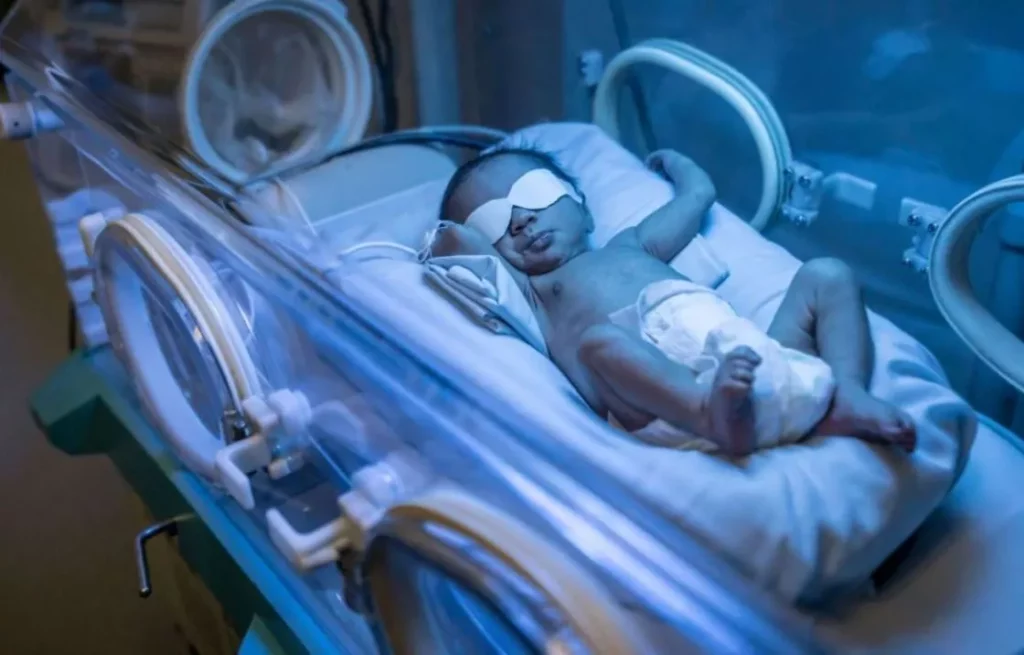OVER VIEW
Contents
Jaundice in newborn babies is one of the most common health issues, especially seen 1 week after birth.
Newborn jaundice is a yellow of a baby’s skin and eyes. it occurs when babies have a high amount of bilirubin, which is found in RBC and causes jaundice.
It is a common and usually harmless medical condition, symptoms in a new baby are – pale skin, due to bilirubin present in the liver.
Jaundice goes away within 2 weeks, but some babies, (about 1 in 20 babies) have a high level of bilirubin that requires treatment.
Treatment is also very simple where the doctor puts a baby under blue light.
It affected about 6 out of every 10 babies, and 8 out of 10 premature babies develop jaundice, it also affects adults or other underlying conditions.
Types of Jaundice
Commonly, physiological jaundice is the most common type however in some regions pathological jaundice is also common.
Here are common types of newborn babies jaundice including:
Physiological jaundice
It is the most common type and considered normal.
This type usually appears between 24 to 72 h of age, and it is at its peak in the newborn between the 4th and 5th days, which disappears in 10 to 14 days of life (2)
Breastfeeding jaundice
It usually appears between 24–72 h of age, peaks by 5–15 days of life and disappears by the third week of life.
A mild sign of jaundice in a breastfeeding newborn may reoccur after 10 to 14 days or during the breastfeeding period (3).
NOTE: To prevent jaundice in healthy babies, mothers should breastfeed their babies at least 10–12 times per day.
In addition, it is not recommended to stop breastfeeding until the levels exceed 20 mg/dl.
Hemolytic jaundice
Jaundice appearing within 24 h should be managed as hemolytic jaundice.
Pathological jaundice
NOTE: Jaundice in newborn babies is common around 50%–60% of newborns in the first week of life (4).
NOTE: About 80% of premature babies develop jaundice during their 1 week of life (5).
What is considered a Normal level?
According to the American Academy of Pediatrics (AAP), bilirubin levels up to 17 to18 mg/dl may be accepted as normal in healthy newborns (6).
A high level of bilirubin can place a baby at risk of brain damage.
Furthermore, bilirubin levels usually peak between 3 to 7 days after birth.
How to check bilirubin levels in babies?
A doctor checks jaundice level through the bilirubin meter method (shining a light on the baby’s skin from which the level of bilirubin is calculated).
To check newborn jaundice – gently press on the baby’s forehead or nose. If the skin looks yellowish (where you pressed), then it’s possible that the baby has mild jaundice.
Reasons and Risk
Excess bilirubin is the main cause of jaundice, but how?
Bilirubin is a yellow-orange substance, which is found in Red Blood Cells, but when the liver is not able to function properly.
Then the bilirubin starts deposited in the liver, which makes the skin and eyes look yellow, causing jaundice.
Here are other possible reasons for jaundice in newborn babies are:
- Newborn infants are more chance of getting jaundice because their liver isn’t mature enough to get rid of bilirubin in the bloodstream.
- Born too early or premature
- Infection
- Decreased enzyme activity in infants
- Thyroid hormone deficiency in baby
- If there is a blockage in the gallbladder or if it is not made properly, this could also be the reason.
- Liver issues
Which babies are most at risk of jaundice?
Babies who are at high risk of developing jaundice include:
- Blood incompatibility: When the child’s blood group is different from the mother’s blood group can also increase jaundice risk.
- Babies who aren’t getting enough breast milk
- Race – studies show that babies of East Asian Descent have a higher risk of developing jaundice.
- Low birth weight: A baby whose weight is less than 2.5 is at increased risk of developing jaundice.
Symptoms
Its symptoms may start within 2 to 4 days after birth and can last for 2 to 3 weeks, how long it last, depends on the bilirubin level in the body.
This can first be seen on the face, but when the bilirubin level rises in the baby’s body, it proceeds to the other body parts such as the extremities.
Some common symptoms that can be observed in a newborn with jaundice include are:
- Babies seem yellow, especially seen in eyes, and skin, which you can see easily in natural sunlight.
NOTE: If the hands and feet of the baby look pale as a face, then the child should be brought to the hospital.
Jaundice may be difficult to see in Dark skin color, but you check the eyes of color, and under the tongue.
Complications
The complications that arise are more serious and it’s mostly mental, which are permanent in most cases like:
- Mentally handicapped child.
- Ear deafness.
- Stopped mental development of the child.
- Seizures like epilepsy.
- The child’s body would become loose or stiff.
Tests
In most cases, the doctor can find out only by looking at the baby whether the child has jaundice or not.
Also, the doctor also does some tests which find out what is the level of bilirubin in the baby’s body, which helps in the treatment.
Some tests performed by doctors include:
Blood test: This involves taking a drop of blood from the baby’s food, which determines the bilirubin quantity.
Light test: In this, a device shines a light on the skin of the child, which measures the reflection of light that shines through her skin.
A doctor may perform some other tests which include:
- A urine test to check for infection
- A blood test that measures the RBC level
- Immune system test, that determines whether RBC are being destroyed due to the immune system.
- Liver function test
The baby is also checked every 6 to 12 hours after the bilirubin level drops or is neutral.
Treatment

There are various treatment options available, which depend on the bilirubin level in the child. which include:
If babies can’t resolve jaundice within 2 weeks, then treatment is needed, where the focus is on reducing the level of the bilirubin.
Light therapy
A baby is made to lie down under blue light, then a special blanket is used to cover the baby, then light is used.
The main cause of jaundice in babies is high bilirubin level, so this blue light lowers the level of bilirubin in the baby’s blood.
Blue light adds oxygen to the bilirubin so that it dissolves easily in water, then the baby’s liver can break it down easily, allowing bilirubin is easily removed.
At the present time, blue light therapy is often used in treating newborn jaundice in the clinic (7).
It also has some adverse effects such as – temporary rashes, diarrhea, skin color changes, etc (8)
Blood transfusion
It is a rare case if the light therapy does work, or if the baby’s condition is severe, then the doctor may perform a blood transfusion.
Which dilutes the bilirubin level in the red blood cells.
The doctor may do a few tests (after therapy has started) every 4 to 6 hours to check the treatment is working.
Intravenous Immunoglobulin (IVIG)
If jaundice occurs due to Blood incompatibility, the doctor gives blood protein through the IV that helps stop the breakdown of RBC.
This method (IVIG 0.5-1 gr/kg) has proven to be effective in reducing the need for blood transfusion and phototherapy (9) (10).
Prevent Jaundice In Newborn babies?
- If you are breastfeeding, then make sure to feed the baby 8 to 10 times for a few days of life.
- To a certain extent, exposure to the baby to sunlight also helps to reduce jaundice.
- The mother should also eat enough rich protein, so that baby can take that protein through breastfeeding.
If you notice any signs of jaundice, like skin and eye color yellow, talk to the doctor.
When To worry about it?
In most cases, jaundice is considered a normal medical condition but sometimes it can arise some other underlying medical conditions.
Which increase the risk of brain damage, so whenever you notice some discomfort or other thing, call immediately to the doctor:
- If jaundice spread through the face to other body parts
- Developing fever in a baby
- If the color is too yellow
- If the baby is not feeding enough


